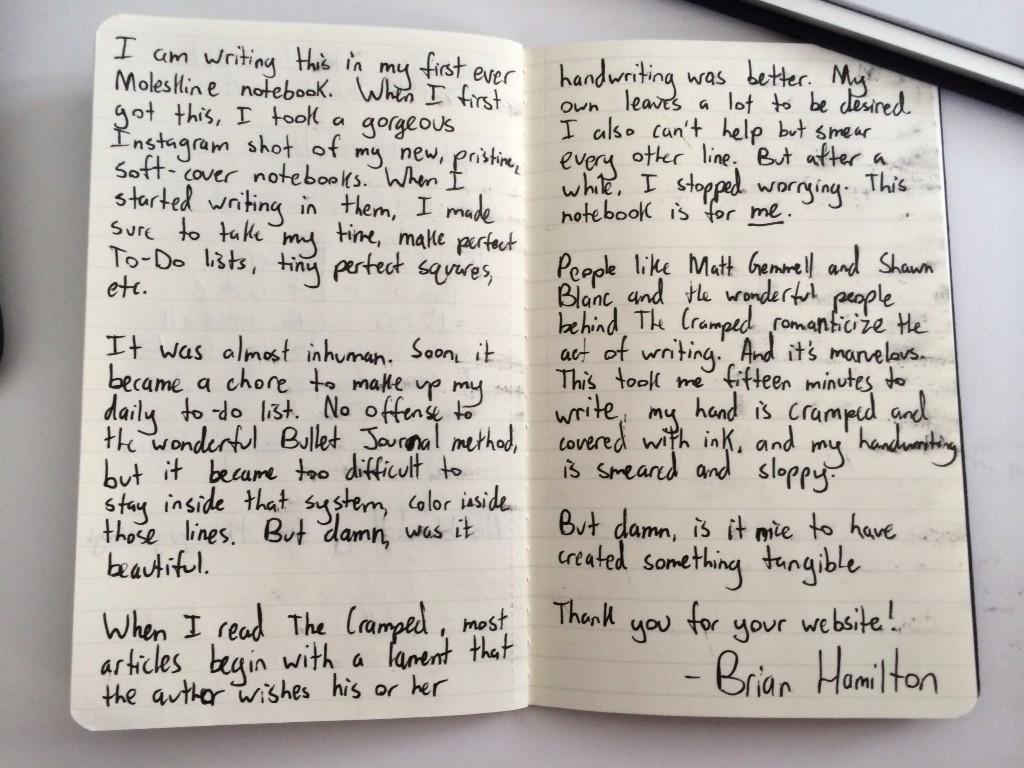How nice it was to open up Twitter after a long day and see this. Thanks, Brian. Glad you are enjoying and finding value in the site.
Handwriting – Matt Gemmell
We’ve lost something. Our instantly-delivered, electronically rendered thoughts are clean and readable, but if we’re honest, they also inhabit a sort of uncanny valley. There’s a degree of removal between the work and the author. Perfect letterforms, lined up algorithmically, standing like an eerie, emotionless army of sinister mannequins.
A lovely thought piece on what we lose when we lose handwriting. By the way, if you are not reading every single word Matt Gemmell writes you are doing yourself a disservice. Easily one of my favorite writers.
This Week’s Pens — 7/13/14 – 7/18/14
I have a lot of pens. Many of which do not see enough use. So, I’m trying something new. On Monday morning, I loaded up my NockCo case with five pens that fit that bill. I then, spent each day this week using a new, new to me, or otherwise rarely-used pen. I’ve retired my usual go-to favorites for now. I’ll keep doing this each week for a while and share some mini-reviews here at the end of the week.
Here’s the pens I used this week:
-
Monday: Uni-ball Signo RT1 UMN-155 Gel Ink Pen – 0.38 mm – Black — Good pen. It’s comfy to write with, thanks to the rubberized grip, and has a consistent line and flow. It’s not as smooth on the page as the Uni-ball 207 micro I regularly use. That said, it is still a decent everyday pen.
-
Tuesday: Pilot Juice Gel Ink Pen – 0.38 mm – Coffee Brown — I’m usually either a Black or Blue-Black ink sort of guy when it comes to everyday pens. So, breaking this one out so early in the week was a personal stretch for me. But, I like the color. It is a rich, leathery brown. Perfectly fine for handwriting. The pen itself is not terrific — it’s a little harsh on the page. Toothy even on Tomoe River paper. While others might be inclined to blame the smaller point size, I know full well from my usual daily gel that it is perfectly possible to make a small point pen that is smooth like butter on the page.
-
Wednesday: Zebra Sarasa Push Clip Gel Ink Pen – 0.3 mm – Black — Proof that you can have a pretty small point size and still provide a smooth writing experience. I was also amazed at the number of people who told me this was their "go-to" when I mentioned it.
-
Thursday: Pilot Metropolitan, F nib, Black from Pen Chalet — This pen was sent to me for review by Pen Chalet. I’ll be doing a longer review soon. The Metropolitan has lately been getting a lot of press as the new gold standard in beginner fountain pens. I wanted to see what all the fuss was about. I can report that it is easy to see why. This is a solid pen for the money (as of this writing it is on sale for $15 at Pen Chalet). Beautiful classic design, great hand feel, and smooth writing. It does not feel cheap at all. This is a great pen and I’m kind of gobsmacked that a pen this good could be made at this price. Feels and writes like a pen costing 3-4 times as much.
-
Friday: Pilot Hi-Tec-C Gel Ink Pen – 0.4 mm – Brown — Once again trying some brown ink. If you are familiar with the Hi-Tec-C, well, this is that same great pen with some nice brown gel ink. Ask ink colors go, I think I prefer the Pilot Juice Coffee Brown but I much prefer this pen in writing experience. If I had to choose, based on that this pen would win every time.
Longhand
by Shawn Mihalik
In August of last year I bought a large leather-bound unruled notebook. I don’t have the notebook anymore, and I don’t remember the brand, but it was black and heavy and felt substantial when I pulled it from my bag and placed it on my grandmother’s dining room table. My grandmother was 89 years old at the time. Her mind was going. She was paying me to take care of her, to spend evenings and nights in her home—a house she and her husband, dead now ten-plus years, built with their own hands when they were young. This was in Ohio. My first novel was a few months from publication and I was starting on my second. That’s what this new notebook was for—writing my second novel.
Joyce Carol Oates writes her novels in longhand, I’d recently read. I wanted to write a novel in longhand too. I wanted to be a great writer.
So between tasks for my grandmother—preparing her dinner (often just a sandwich on white bread, frozen because she went through a loaf so slowly, or a pan-fried hot dog or reheated pasta that one of her daughters had brought her that afternoon or half a pint of chocolate pecan ice cream I’d purchased for her on my way to her house—these were the things she liked), dusting her floors, showing her more than once how to dial from the old flip cellphone she never did use—I sat at her dining room table and wrote in that notebook. I wrote with a Montegrappa Symphony Yellow fountain pen I’d been given as a gift a year before. I still have that Montegrappa, but I rarely use it now because I’m left handed and fountain pens have proven problematic.
I’d stop writing at 7 PM, when Wheel of Fortune came on. With my grandma I’d watch it, and then we’d watch Jeopardy!. “You have to read a lot of books, Shawn, if you ever want to be good at Jeopardy!,” my grandma would say at least twice per episode. “And I don’t mean novels and stuff like that. Real books. You have to read real books.”
And after Jeopardy!, she’d go to bed. I’d walk her over to the stairs, but the stairs themselves she insisted on climbing unaided. Her daughters never did understand why she stayed in that house with the stairs, why she wouldn’t enter an assisted living facility or something. After she went to bed I’d pour myself a beer or a cider and write some more.
I wrote like this for about a week before I gave up. I wrote a single chapter, about 3000 words, before I finally admitted to myself that my handwriting was abysmal, that I’d never even be able to read back what I was writing, so what was the point.
I stopped bringing the notebook and the Montegrappa to my grandmother’s with me. I spent the next two months eating with her instead, talking to her, listening to her stories, not caring that they were the same stories every time and that yet the details always changed, that sometimes in the stories her husband was still alive, that sometimes in the stories she had three children and sometimes only two, that she’d ask me about my sister, who no one in our family had spoken to in three years, and say “Whatever happened to that girl? What was her name?”
I moved from Ohio to Montana in October. My first novel came out in November. My second is now finished—I wrote it in Scrivener.
Near the end of February, 22 days after her 90th birthday, and 11 days after my 24th, my grandmother died.
I recently bought two new notebooks. They’re nothing special, just softcover Moleskines, one small, which stays in my back pocket, the other larger and either on my desk or in my bag. They’re both unruled like that first one. Writing in them comes easier to me now, although I don’t why. I fill their pages daily, with either a black Pilot G2 .7 inch or a red Uni-ball Vision Stick Micro Point Roller Ball. I wrote in 30 minutes the 700 words that became this essay in the large one. I can usually read what I’ve written now, too.
Shawn Mihalik is a writer, editor, and publisher based in Missoula, MT. He is the author of two works of fiction: The Flute Player, a novella, and Brand-Changing Day, a novel. Shawn can be found on Twitter at @shawnmihalik.
“Weird Al” Yankovic – Word Crimes – YouTube
How could I not post this (especially because no less than a dozen people sent it my way this morning)? It really is great.
Moleskine Voyageur, A Traveller’s Notebook – Moleskine United States
Moleskine Voyageur, A Traveller's Notebook – Moleskine United States
A new sized notebook for Moleskine in a portable format designed to store printed emails, itineraries and maps. The essential travelling companion that keeps track of your observations and explorations on the road, so you can concentrate on posting your pics for the folks back home.
Looks like Moleskine is getting into the traveling notebook game. Looks like it has some nice features.
Pocket Department Notebooks, reviewed | Woodclinched
Pocket Department Notebooks, reviewed | Woodclinched
Andy reviews some rather unique new notebooks that are each designed to fit a specific pocket. Interesting idea.
Palomino announced a new line of notebooks to complement their Blackwing and Blackwing 602 pencils. The Blackwings are probably the best pencils I’ve ever used, so I have high hopes for their new notebook. Looks great.
Always Open To The Possibility Of Writing
Sometime in the early 2000’s, people stopped asking me whether or not I wrote on a computer. Before that, there was still some expectation that a writer should labor over a manual typewriter, or perhaps a legal pad, wearing pencils down to a stub. The entire act of literary creation was steeped in mystery and romance—it was voodoo, really, a kind of ritual bloodletting. Computer use was new and controversial—people wanted to know what side I came down on.
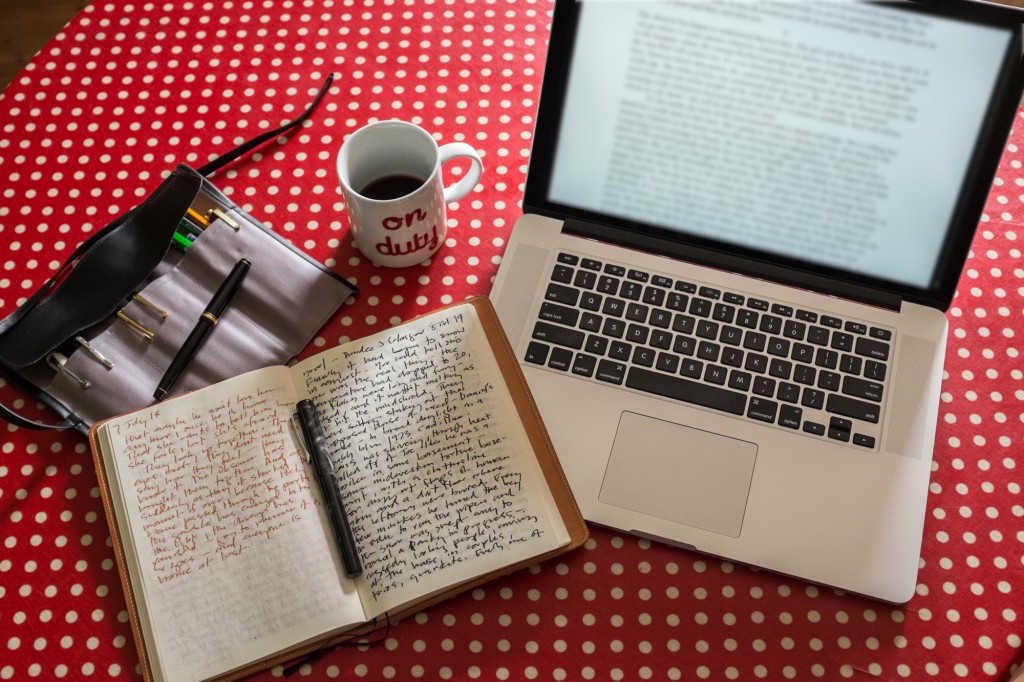
But all that changed with the rise of the laptop and the MFA program, two tools that demystified the writing process and made it available to more people. The former allowed anyone to create a literary work that, if nothing else, looked professional; the latter seemed to offer formal training and certification that turned any hack writer into something a little bit tamer and more authoritative: an “author.” Now everybody assumed you had a writing degree. Everybody assumed you were using a computer.
I came to miss those old questions, the ones that seemed to come largely from people who merely liked to read, for whom the idea of writing anything more complicated than a thank-you note might have seemed an insurmountable task. These days, most of the questions I get at readings, conferences, and the like come from people who are writers themselves, or are trying to be. How can I get into your school? Do you know anybody at The New Yorker I can send this to? Would you read something of mine? How do you get an agent? Not only have fiction and poetry writing become more egalitarian, less resistant to entry—publication has, too. If you don’t mind eschewing print (and money, of course), you can publish in any number of online journals. You can post your work on a blog or on an internet messageboard. You can self-publish your ebook. Your print book, even, for a price. Everybody’s a writer now.
Though a lot of us have wrung our hands over the death of the old-school gatekeepers, I think these changes are, broadly speaking, a good thing for the literary world. A culture more engaged with writing is one that any writer should want to be a part of. But among the things we seem to have lost is the idea that writing is a dark and unfathomable process. The irony, of course, is that it still is—it’s the same as it’s ever been. The technological ease of its production is largely illusory—our methods for making it are as arcane and diverse as ever, even if we’re all ultimately using Macbooks to push it out into the world.
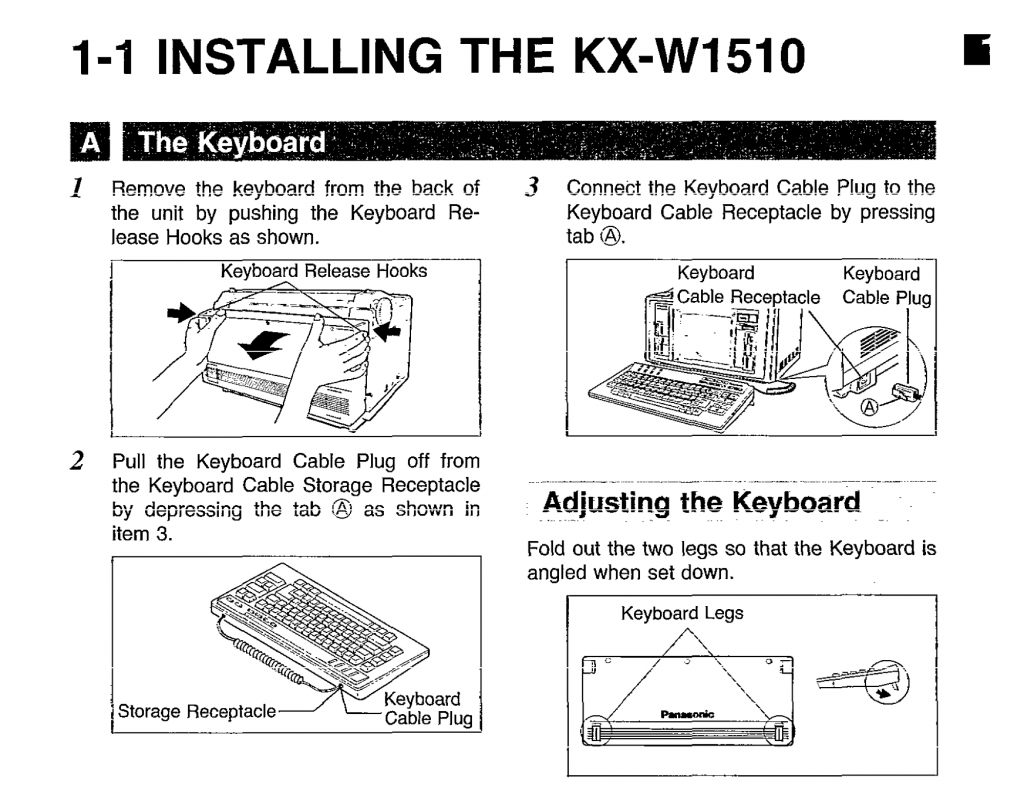
I’m a fairly technically inclined person, so I’ve always liked up-to-date writing tools. I loved my parents’ Royal upright typewriter when I was a child, and graduated to a humming Selectric (or maybe it was an Olivetti) in high school. I wrote my first abortive college novel on a glorified electric typewriter with a little LCD preview screen, and my first published novel on a standalone Panasonic word processor (I’m pretty sure it was the KX-W1510) with a built-in clackity printer that shook the pressboard buffet table it lived on. I’ve since composed with WordPerfect on a greenscreen IBM, and on the earliest Macintoshes; I wrote my novel Mailman on a Toshiba laptop as thick as a turkey club sandwich and now use good old bloated Microsoft Word, fullscreen and in “focus” view, on, yes, a Macbook Air or Pro. For the most part, my work is, or has been, tool-agnostic—the theoretical ideal is for the tech to disappear and the words to transfer from brain to page without resistance.
But lately I’ve gotten kind of throwbacky. It’s not the first time. In the early 2000’s, when the computer was taking over as the default writing tool, I tried drafting a novel with pencil and paper—it would eventually be published under the title On the Night Plain. The book takes place in the 1940’s, and I wanted to try using period tech. The second draft was typed up on an Underwood that I still own (though several generations of mice have tried living in it since, rendering it inoperable), and it wasn’t until the third that I finally transferred it all into a computer. I edited those early drafts with a red pen, at times literally cutting and pasting in the time-honored manner, with scissors and glue stick.
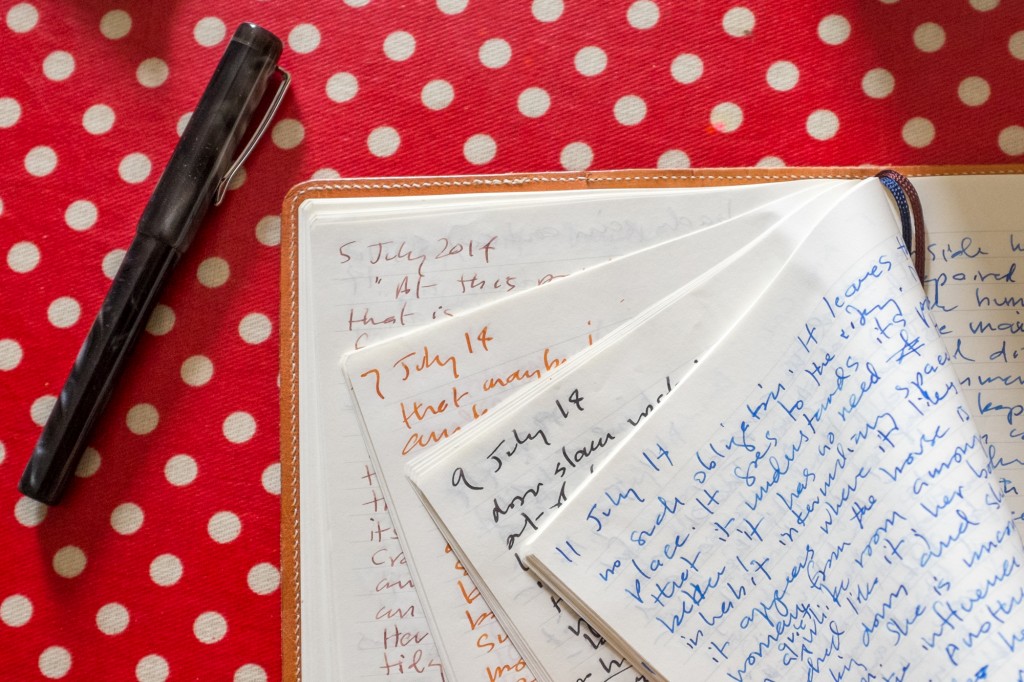
I was all digital for another decade after that, and then this past winter, vexed by professional obligations that had nothing to do with writing and that were haunting my digital life, I hauled out my old fountain pens—a couple of cheap Sheaffers, of the sort my wife and I used to use in the early nineties, and two Mont Blancs, one a college graduation present from my grandfather, the other inherited from him when he died. I had also received a Lamy Safari as a gift from a student of mine, but hadn’t got around to using it. I looked these pens up on the internet to remind myself how to put ink into them, and discovered the sprawling online world of pen, pencil, and stationery enthusiasts. The bookstore at the college where I work started stocking Rhodia pads and journals, and I started listening to the Pen Addict podcast. I also befriended some younger writers who encouraged me to join them at coffee shops for writing sessions. I hadn’t done this—working with others—for a couple of decades, and at first felt weird and exposed. But it turns out that there’s nothing that motivates quite like the sight of your friend covering pages with ink. Are you going to sit there like a loser, with your blank page? No, you are not.
My process these days varies according to what I’m writing, where it’s going to end up, and how urgent it is. I still write blog posts, student editorial memos, book reviews, and some fiction directly on the computer. But most of the short fiction I’ve written in 2014, and a lot of the novel I’ve been working on, has been drafted with a fountain pen into my favorite bound journal, the Nanami Paper Seven Seas Writer. This 480-page A5-size lined notebook is made out of the extraordinarily smooth and supple Tomoe River paper, from Japan’s Tomoegawa Co., Inc.; I keep mine tucked into a Gfeller Casemakers leather cover. I’ve now got a bunch of pens, new and old, to choose from; I particularly love the offerings from Pilot, TWSBI, Lamy, and Franklin-Christoph. I favor pens that can be filled from bottled inks—it means that every few weeks I can re-ink them with new colors. This lends a little variety to my daily life, and makes it easier to see where I left off and picked up between sessions. I switch pens for every writing session, write the date (and location, if I’m not at home) at the top of each page, and go to work. I generally write in the morning, and transfer what I’ve written to the computer in the afternoon or on the weekend, editing it on the way. (As for the digital end of my workflow—I tried a few alternate word processing programs, particularly Scrivener, which takes a skeuomorphic approach to organizing ideas. But ultimately, I’ve stuck with Word. You can customize away all the unnecessary garbage. A novel, for me, ends up as one big .doc file, no section breaks.)
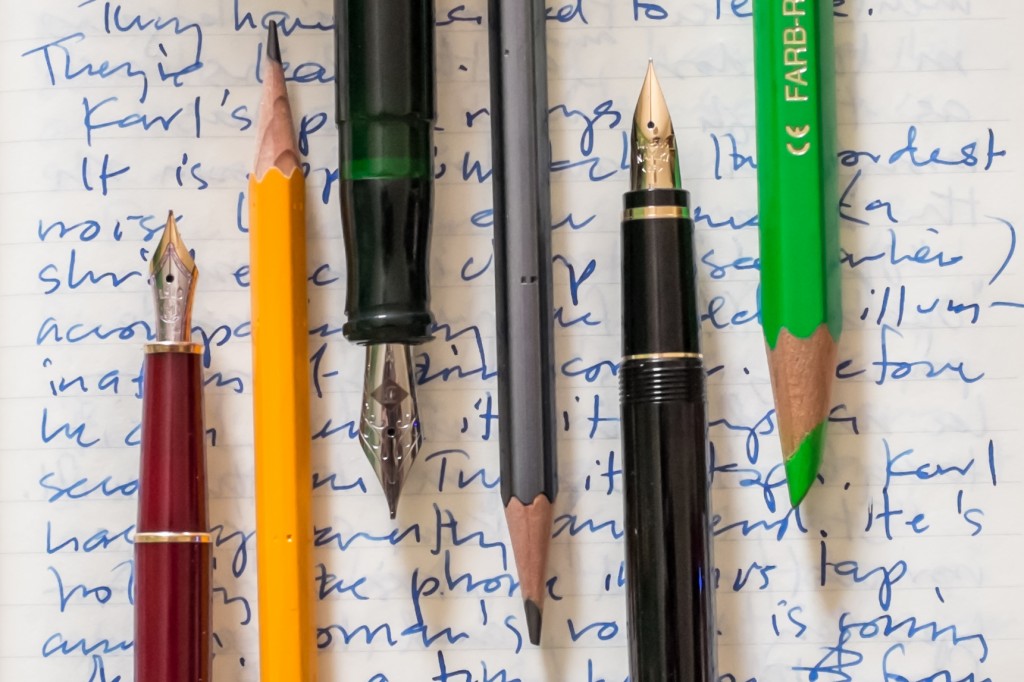
I don’t typically use the Seven Seas Writer for note-taking or list-making—for that, I’ll generally use a Field Notes. I like the ones with the newer, thicker paper—the America the Beautiful edition, or the new Shelterwood. When I’m teaching, I generally have a fresh page of an A4-size Rhodia pad in front of me (ideally a wire-bound dot grid, but I’ll use whatever the college store has in stock), clamped to an aluminum legal-size clipboard I custom-cut to fit A4; because I’m bad with names (which is another way of saying I’m lazy and inattentive), I jot down the name of anyone who speaks and make a note on what they say, in case I need to refer to it later. A student recently suggested that I write down whose hands go up and in what order, so that nobody gets left out; I do that now, too. In class I’ll use a rollerball pen, usually my Retro 51 Tornado or Karas Kustoms Retrakt, as this kind of writing is intermittent, and might cause a fountain pen nib to dry out.
Much is said about the portability of new laptops, particularly the Macbook Air. But I’m finding that I am much more likely to pull out a notebook and pen from my bag in public than I am a laptop—indeed, I’m more likely to bring them with me in the first place. If you’re never without a notebook, you’re always open to the possibility of writing. And analog tech has also freed me from the idea that I’m writing something important, official, or canonical—my crap handwriting makes me feel as though I’m just fooling around, which, ultimately, is how a lot of my best ideas are generated.
In other words, I’ve spent my entire life attempting to professionalize my passion—and now that I’ve succeeded in establishing a publishing and teaching career, I’ve backtracked, to try to make it seem like a hobby again—the way it felt in my youth, before I had a laptop or MFA. I’m still waiting for people to start asking me at readings about my favorite pens and paper—but since I’m clearly not the only writer rediscovering the pleasures of an analog workflow, it’s probably inevitable.
J. Robert Lennon is the author seven novels, including Mailman, Familiar, and Happyland, and the story collections Pieces for the Left Hand and See You in Paradise. The latter will be published by Graywolf Press in November. He teaches writing at Cornell University. He can be found on Twitter @jrobertlennon and blogs regularly at Literambivalence
The Shape of Days — Austin Kleon
The Shape of Day’s — Austin Kleon
I think our days have shapes, too — each has a beginning and an end, and we go through good and ill fortune as it progresses.
A neat idea to consider adding to your journaling process.

